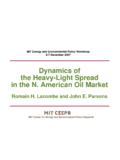Transcription of THE RELATIONSHIP BETWEEN CREDIT DEFAULT SWAP …
1 THE RELATIONSHIP BETWEEN CREDIT DEFAULT SWAP spreads , BOND YIELDS, AND CREDIT RATING ANNOUNCEMENTS John Hull, Mirela Predescu, and Alan White* Joseph L. Rotman School of Management University of Toronto 105 St George Street Toronto, ON M5S 3E6 Canada e-mail addresses: First Draft: September 2002 This Draft: March 2003 * Joseph L. Rotman School of Management, University of Toronto. We are grateful to Moody's Investors Service for financial support and for making their historical data on company ratings available to us.
2 We are grateful to GFI for making their data on CDS spreads available to us. We are also grateful to Jeff Bohn, Richard Cantor, Yu Du, Darrell Duffie, Jerry Fons, Louis Gagnon, Hui Hao, Lew Johnson, Roger Stein and participants at a Fields Institute seminar, meetings of the Moody's Academic Advisory Committee, a Queens University workshop, and an ICBI Risk Management conference for useful comments on earlier drafts of this paper. Matthew Merkley and Huafen (Florence) Wu provided excellent research assistance. Needless to say, we are fully responsible for the content of the paper.
3 2 THE RELATIONSHIP BETWEEN CREDIT DEFAULT SWAP spreads , BOND YIELDS, AND CREDIT RATING ANNOUNCEMENTS Abstract A company s CREDIT DEFAULT swap spread is the cost per annum for protection against a DEFAULT by the company. In this paper we analyze data on CREDIT DEFAULT swap spreads collected by a leading CREDIT derivatives broker. We first examine the RELATIONSHIP BETWEEN CREDIT DEFAULT spreads and bond yields and reach conclusions on the benchmark risk-free rate used by participants in the CREDIT derivatives market. We then carry out a series of tests to explore the extent to which CREDIT rating announcements by Moody s are anticipated by participants in the CREDIT DEFAULT swap market.
4 3 THE RELATIONSHIP BETWEEN CREDIT DEFAULT SWAP spreads , BOND YIELDS, AND CREDIT RATING ANNOUNCEMENTS CREDIT derivatives are an exciting innovation in financial markets. They have the potential to allow companies to trade and manage CREDIT risks in much the same way as market risks. The most popular CREDIT derivative is a CREDIT DEFAULT swap (CDS). This contract provides insurance against a DEFAULT by a particular company or sovereign entity. The company is known as the reference entity and a DEFAULT by the company is known as a CREDIT event.
5 The buyer of the insurance makes periodic payments to the seller and in return obtains the right to sell a bond issued by the reference entity for its face value if a CREDIT event occurs. The rate of payments made per year by the buyer is known as the CDS spread. Suppose that the CDS spread for a five-year contract on Ford Motor CREDIT with a principal of $10 million is 300 basis points. This means that the buyer pays $300,000 per year and obtains the right to sell bonds with a face value of $10 million issued by Ford for the face value in the event of a DEFAULT by The CREDIT DEFAULT swap market has grown rapidly since the International Swaps and Derivatives Association produced its first version of a standardized contract in 1998.
6 CREDIT ratings for sovereign and corporate bond issues have been produced in the United States by rating agencies such as Moody's and Standard and Poor's (S&P) for many years. In the case of Moody's the best rating is Aaa. Bonds with this rating are considered to have almost no chance of defaulting in the near future. The next best rating is Aa. After that come A, Baa, Ba, B and Caa. The S&P ratings corresponding to Moody's Aaa, Aa, A, Baa, Ba, B, and Caa are AAA, AA, A, BBB, BB, B, and CCC respectively. To create finer rating categories Moody's divides its Aa category into Aa1, Aa2, and Aa3; it divides A into A1, A2, and A3; and so on.
7 Similarly S&P divides its AA category into AA+, AA, 1 In a standard contract, payments by the buyer are made quarterly or semiannually in arrears. If the reference entity defaults, there is a final accrual payment and payments then stop. Contracts are sometimes settled in cash rather than by the delivery of bonds. In this case there is a calculation agent who has the 4and AA ; it divides its A category into A+, A, and A ; etc. Only the Moody's Aaa and S&P AAA categories are not subdivided.
8 Ratings below Baa3 (Moody s) and BBB (S&P) are referred to as below investment grade . Analysts and commentators often use ratings as descriptors of the creditworthiness of bond issuers rather than descriptors of the quality of the bonds themselves. This is reasonable because it is rare for two different bonds issued by the same company to have different ratings. Indeed, when rating agencies announce rating changes they often refer to companies, not individual bond issues. In this paper we will similarly assume that ratings are attributes of companies rather than bonds.
9 The paper has two objectives. The first is to examine the RELATIONSHIP BETWEEN CREDIT DEFAULT swap spreads and bond yields with a view to reaching conclusions on the benchmark risk-free rate used by participants in the CREDIT derivatives market. The second is to examine the RELATIONSHIP BETWEEN CREDIT DEFAULT swap spreads and announcements by rating agencies. The analyses are based on over 200,000 CDS spread bids and offers collected by a leading CREDIT derivatives broker over a five-year period. As discussed below a number of researchers have explored the RELATIONSHIP BETWEEN bond yields and CREDIT rating announcements.
10 CREDIT DEFAULT swap spreads are an interesting alternative to bond yields for two reasons. The first is that the CDS spread data provided by a broker consists of firm bid and offer quotes from dealers. Once a quote has been made, the dealer is committed to trading a minimum principal (usually $10 million) at the quoted price. By contrast the bond yield data available to researchers usually consist of indications from dealers. There is no commitment from the dealer to trade at the specified price. The second attraction of CDS spreads is that no adjustment is required: they are already CREDIT spreads .







